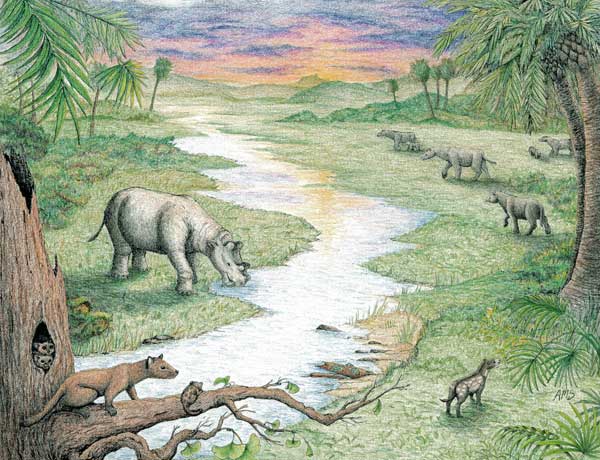



|
TOPICS BONOBO Chimpanzee "Ai" Crania photos Itani Jun'ichiro archives Open datasets for behavioral analysis Guidelines for Care and Use of Nonhuman Primates(pdf) Study material catalogue/database Guideline for field research of non-human primates 2019(pdf) Primate Genome DB 
Primate Research Institute, Kyoto University Copyright (c) |
Japanese Carnivorous mammals from the middle Eocene Washakie Formation, Wyoming, USA, and their diversity trajectory in a post-warming world
Susumu Tomiya, Shawn P. Zack, Michelle Spaulding and John J. Flynn
Abstract
The middle Eocene Washakie Formation of Wyoming, USA, provides a rare window, within a single depositional basin, into the faunal transition that followed the early Eocene warming events. Based on extensive examination, we report a minimum of 27 species of carnivorous mammals from this formation, more than doubling the previous taxic count. Included in this revised list are a new species of carnivoraform, Neovulpavus mccarrolli n. sp., and up to ten other possibly new taxa. Our cladistic analysis of early Carnivoraformes incorporating new data clarified the array of middle Eocene taxa that are closely related to crown-group Carnivora. These anatomically relatively derived carnivoraforms collectively had an intercontinental distribution in North America and east Asia, exhibiting notable variations in body size and dental adaptation. This time period also saw parallel trends of increase in body size and dental sectoriality in distantly related lineages of carnivores spanning a wide range of body sizes. A new, model-based Bayesian analysis of diversity dynamics accounting for imperfect detection revealed a high probability of substantial loss of carnivore species between the late Bridgerian and early Uintan North American Land Mammal 'Ages', coinciding with the disappearance of formerly common mammals such as hyopsodontids and adapiform primates. Concomitant with this decline in carnivore diversity, the Washakie vertebrate fauna underwent significant disintegration, as measured by patterns of coordinated detection of taxa at the locality level. These observations are consistent with a major biomic transition in the region in response to climatically induced opening-up of forested habitats.  artwork by Adrienne Stroup [https://adriennestroup.wordpress.com/], used with permission
Bibliographic information
Susumu Tomiya, Shawn P. Zack, Michelle Spaulding & John J. Flynn. 2021. Carnivorous mammals from the middle Eocene Washakie Formation, Wyoming, USA, and their diversity trajectory in a post-warming world, Paleontological Society Memoir 82 (Supplement to Journal of Paleontology 95): 1-115. https://doi.org/10.1017/jpa.2020.74 2021/03/26 Primate Research Institute
|